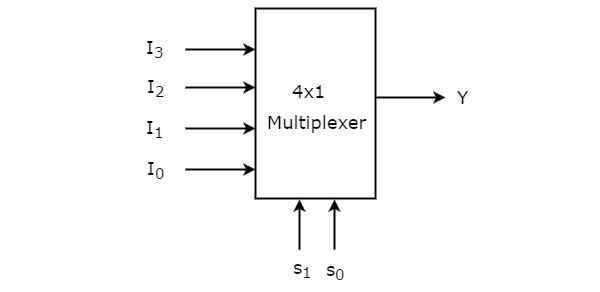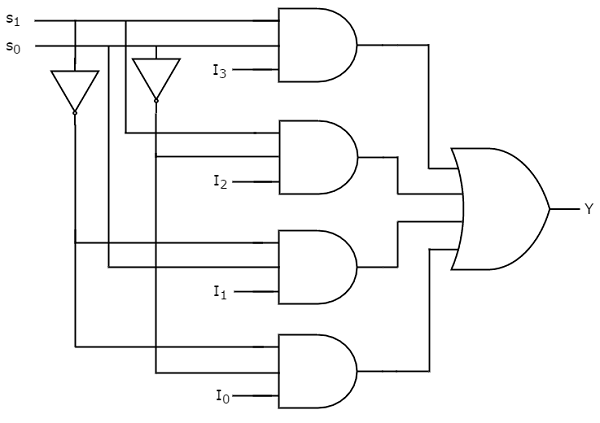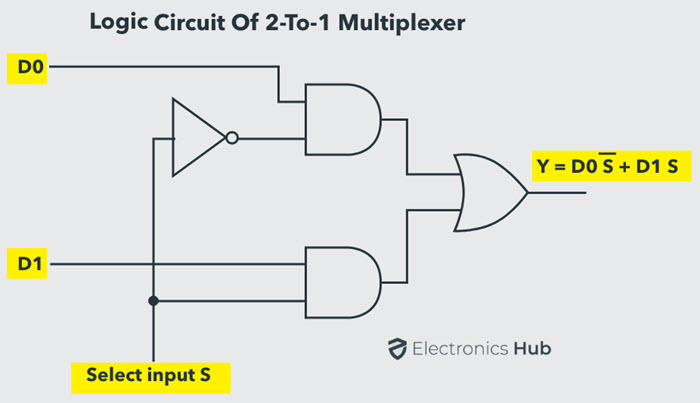CS274: Computer Architecture - 1 Bit ALU Design (100 Points)
Assignment Goals
The goals of this assignment are:- To synthesize an adder and classic logic gates into a 1-bit ALU
Background Reading and References
Please refer to the following readings and examples offering templates to help get you started:The Assignment
What to Do
Create a 1-bit ALU
Using the adder circuit from the prior lab, create a 1-bit ALU by creating and wiring the following additional components:
- Create and test a 3-bit and gate, and a 4-bit or gate
- Create and test a 4-to-1 multiplexor according to the design below. You will create four input pins (
I0,I1,I2, andI3), one select input (s: a 2-bitstd_logic_vector), and an output pin. Create four internal signals (sig1,sig2,sig3, andsig4) to hold the intermediate values. You can port map four and gates to signals like this:signal not_s0, not_s1 : std_logic; ... not_s0 <= not s(0); not_s1 <= not s(1); A1: and3 port map(w => I0, x => not_s0, y => not_s1, z => sig1);Using these and gates, allow
I0to pass whensis10,I1whensis01, and so on. If a bit ofsis0, invert it to produce a1. Finally, You canortogether the four internal signals, and wire that to the output pin, to complete the multiplexor. Note that if you only need fewer than 4 inputs to your multiplexor (say, one for the adder, one for theandgate, and one for theorgate), you can simply wireI0,I1, andI2to those pins or signals, and then create a placeholder signal that you can wire toI3. This will leave that pin essentially disconnected, or "floating". In other words, you can port mapI3to'0'.


- Create a structural ALU component that wires together a 2-bit and gate, a 2-bit or gate, and a full adder, and then multiplexes them together according to a select input, as shown in this design:

Your ALU will include an input calledALUOp, which is astd_logic_vector(1 downto 0). You will wire this to the select input of the mux to choose which operation your ALU will perform!
When finished with this base design, make the following modification.
Subtraction
- Create and test a 2-to-1 multiplexor according to this design (note that your select input will only be 1 bit now!):

- Add a
bInvertinput bit to your design, and multiplex the input signalbwithnot b(using a 2-input mux), and use the resulting mux output as a signal to the remainingbinputs.
Testing
Here is an example testbench for the 1-bit ALU (you may need to change the labels to match the ones you used). It’s a good idea to also assert the values of the flag signals like zero, less, and overflow, which is left as an exercise for you.
library ieee;
use ieee.std_logic_1164.all;
entity alu1bit_tb is
end alu1bit_tb;
architecture behavior of alu1bit_tb is
component alu1bit
port (
a : in std_logic;
b : in std_logic;
carryin : in std_logic;
bInvert : in std_logic;
select : in std_logic_vector(1 downto 0);
z : out std_logic;
carryout : out std_logic;
zero : out std_logic;
less : out std_logic;
overflow : out std_logic
);
end component;
signal ta, tb, carryin, bInvert : std_logic;
signal tselect : std_logic_vector(1 downto 0);
signal tz, tcarryout, tzero, tless, toverflow : std_logic;
begin
uut: alu1bit port map (
a => ta,
b => tb,
carryin => tcarryin,
bInvert => tbInvert,
select => tselect,
z => tz,
carryout => tcarryout,
zero => tzero,
less => tless,
overflow => toverflow
);
tb_proc: process
begin
-- Test ADD (select = "00", bInvert = '0')
tselect <= "00"; tbInvert <= '0';
ta <= '0'; tb <= '0'; tcarryin <= '0'; wait for 30 ns; assert tz = '0' report "ADD 0+0+0 failed";
ta <= '0'; tb <= '0'; tcarryin <= '1'; wait for 30 ns; assert tz = '1' report "ADD 0+0+1 failed";
ta <= '0'; tb <= '1'; tcarryin <= '0'; wait for 30 ns; assert tz = '1' report "ADD 0+1+0 failed";
ta <= '0'; tb <= '1'; tcarryin <= '1'; wait for 30 ns; assert tz = '0' report "ADD 0+1+1 failed";
ta <= '1'; tb <= '0'; tcarryin <= '0'; wait for 30 ns; assert tz = '1' report "ADD 1+0+0 failed";
ta <= '1'; tb <= '0'; tcarryin <= '1'; wait for 30 ns; assert tz = '0' report "ADD 1+0+1 failed";
ta <= '1'; tb <= '1'; tcarryin <= '0'; wait for 30 ns; assert tz = '0' report "ADD 1+1+0 failed";
ta <= '1'; tb <= '1'; tcarryin <= '1'; wait for 30 ns; assert tz = '1' report "ADD 1+1+1 failed";
-- Test SUBTRACT (select = "00", bInvert = '1')
tselect <= "00"; tbInvert <= '1';
ta <= '0'; tb <= '0'; tcarryin <= '1'; wait for 30 ns; assert tz = '0' report "SUB 0-0 failed";
ta <= '0'; tb <= '1'; tcarryin <= '1'; wait for 30 ns; assert tz = '1' report "SUB 0-1 failed";
ta <= '1'; tb <= '0'; tcarryin <= '1'; wait for 30 ns; assert tz = '1' report "SUB 1-0 failed";
ta <= '1'; tb <= '1'; tcarryin <= '1'; wait for 30 ns; assert tz = '0' report "SUB 1-1 failed";
-- Test AND (select = "01", bInvert irrelevant)
tselect <= "01"; tbInvert <= '0';
tcarryin <= '0'; -- carryin not used for AND
ta <= '0'; tb <= '0'; wait for 30 ns; assert tz = '0' report "AND 0&0 failed";
ta <= '0'; tb <= '1'; wait for 30 ns; assert tz = '0' report "AND 0&1 failed";
ta <= '1'; tb <= '0'; wait for 30 ns; assert tz = '0' report "AND 1&0 failed";
ta <= '1'; tb <= '1'; wait for 30 ns; assert tz = '1' report "AND 1&1 failed";
-- Test OR (select = "10", bInvert irrelevant)
tselect <= "10"; tbInvert <= '0';
tcarryin <= '0'; -- carryin not used for OR
ta <= '0'; tb <= '0'; wait for 30 ns; assert tz = '0' report "OR 0|0 failed";
ta <= '0'; tb <= '1'; wait for 30 ns; assert tz = '1' report "OR 0|1 failed";
ta <= '1'; tb <= '0'; wait for 30 ns; assert tz = '1' report "OR 1|0 failed";
ta <= '1'; tb <= '1'; wait for 30 ns; assert tz = '1' report "OR 1|1 failed";
report "Testbench finished successfully";
wait;
end process;
end behavior;
Submission
In your submission, please include answers to any questions asked on the assignment page, as well as the questions listed below, in your README file. If you wrote code as part of this assignment, please describe your design, approach, and implementation in a separate document prepared using a word processor or typesetting program such as LaTeX. This document should include specific instructions on how to build and run your code, and a description of each code module or function that you created suitable for re-use by a colleague. In your README, please include answers to the following questions:- Describe what you did, how you did it, what challenges you encountered, and how you solved them.
- Please answer any questions found throughout the narrative of this assignment.
- If collaboration with a buddy was permitted, did you work with a buddy on this assignment? If so, who? If not, do you certify that this submission represents your own original work?
- Please identify any and all portions of your submission that were not originally written by you (for example, code originally written by your buddy, or anything taken or adapted from a non-classroom resource). It is always OK to use your textbook and instructor notes; however, you are certifying that any portions not designated as coming from an outside person or source are your own original work.
- Approximately how many hours it took you to finish this assignment (I will not judge you for this at all...I am simply using it to gauge if the assignments are too easy or hard)?
- Your overall impression of the assignment. Did you love it, hate it, or were you neutral? One word answers are fine, but if you have any suggestions for the future let me know.
- Using the grading specifications on this page, discuss briefly the grade you would give yourself and why. Discuss each item in the grading specification.
- Any other concerns that you have. For instance, if you have a bug that you were unable to solve but you made progress, write that here. The more you articulate the problem the more partial credit you will receive (it is fine to leave this blank).
Assignment Rubric
| Description | Pre-Emerging (< 50%) | Beginning (50%) | Progressing (85%) | Proficient (100%) |
|---|---|---|---|---|
| Algorithm Implementation (60%) | The algorithm fails on the test inputs due to major issues, or the program fails to compile and/or run | The algorithm fails on the test inputs due to one or more minor issues | The algorithm is implemented to solve the problem correctly according to given test inputs, but would fail if executed in a general case due to a minor issue or omission in the algorithm design or implementation | A reasonable algorithm is implemented to solve the problem which correctly solves the problem according to the given test inputs, and would be reasonably expected to solve the problem in the general case |
| Code Quality and Documentation (30%) | Code commenting and structure are absent, or code structure departs significantly from best practice, and/or the code departs significantly from the style guide | Code commenting and structure is limited in ways that reduce the readability of the program, and/or there are minor departures from the style guide | Code documentation is present that re-states the explicit code definitions, and/or code is written that mostly adheres to the style guide | Code is documented at non-trivial points in a manner that enhances the readability of the program, and code is written according to the style guide |
| Writeup and Submission (10%) | An incomplete submission is provided | The program is submitted, but not according to the directions in one or more ways (for example, because it is lacking a readme writeup) | The program is submitted according to the directions with a minor omission or correction needed, and with at least superficial responses to the bolded questions throughout | The program is submitted according to the directions, including a readme writeup describing the solution, and thoughtful answers to the bolded questions throughout |
Please refer to the Style Guide for code quality examples and guidelines.